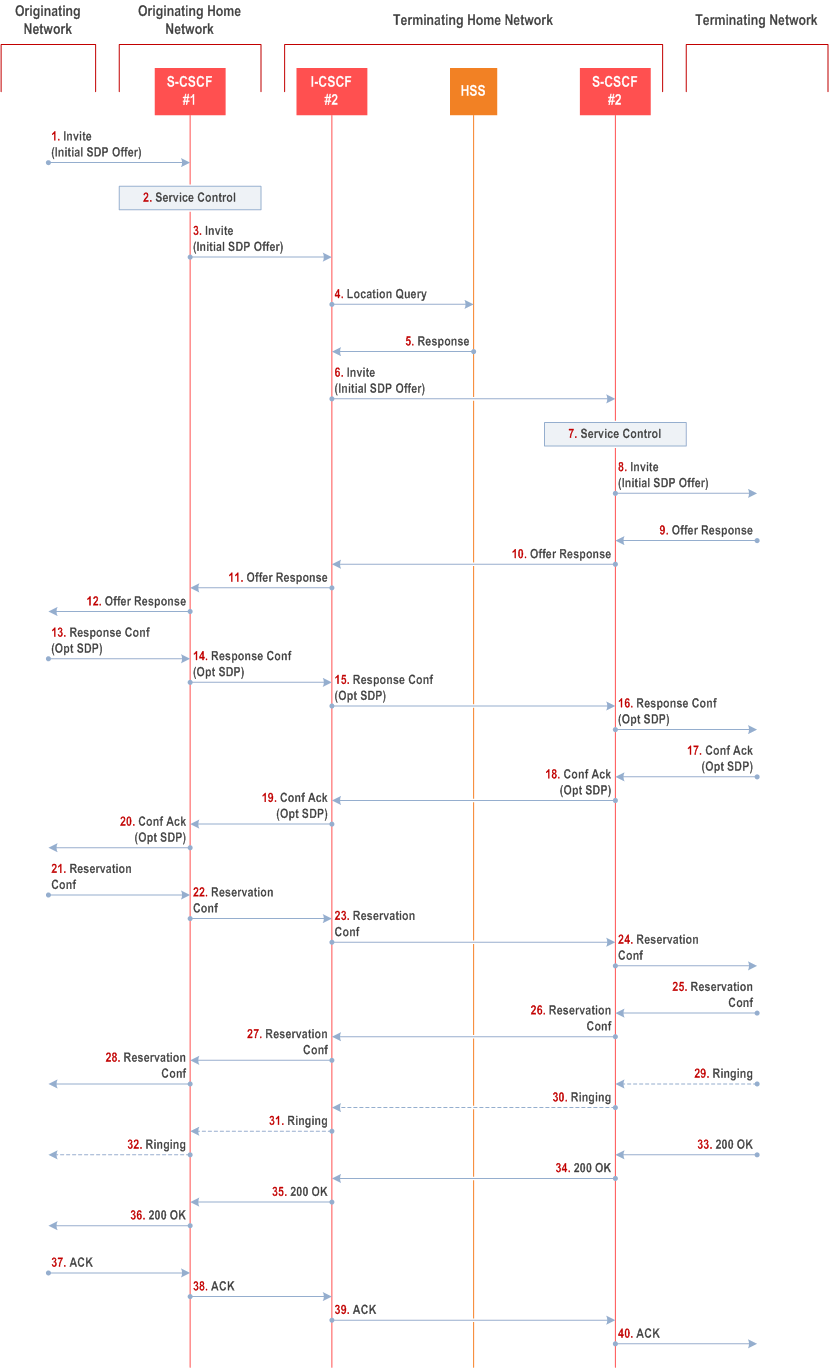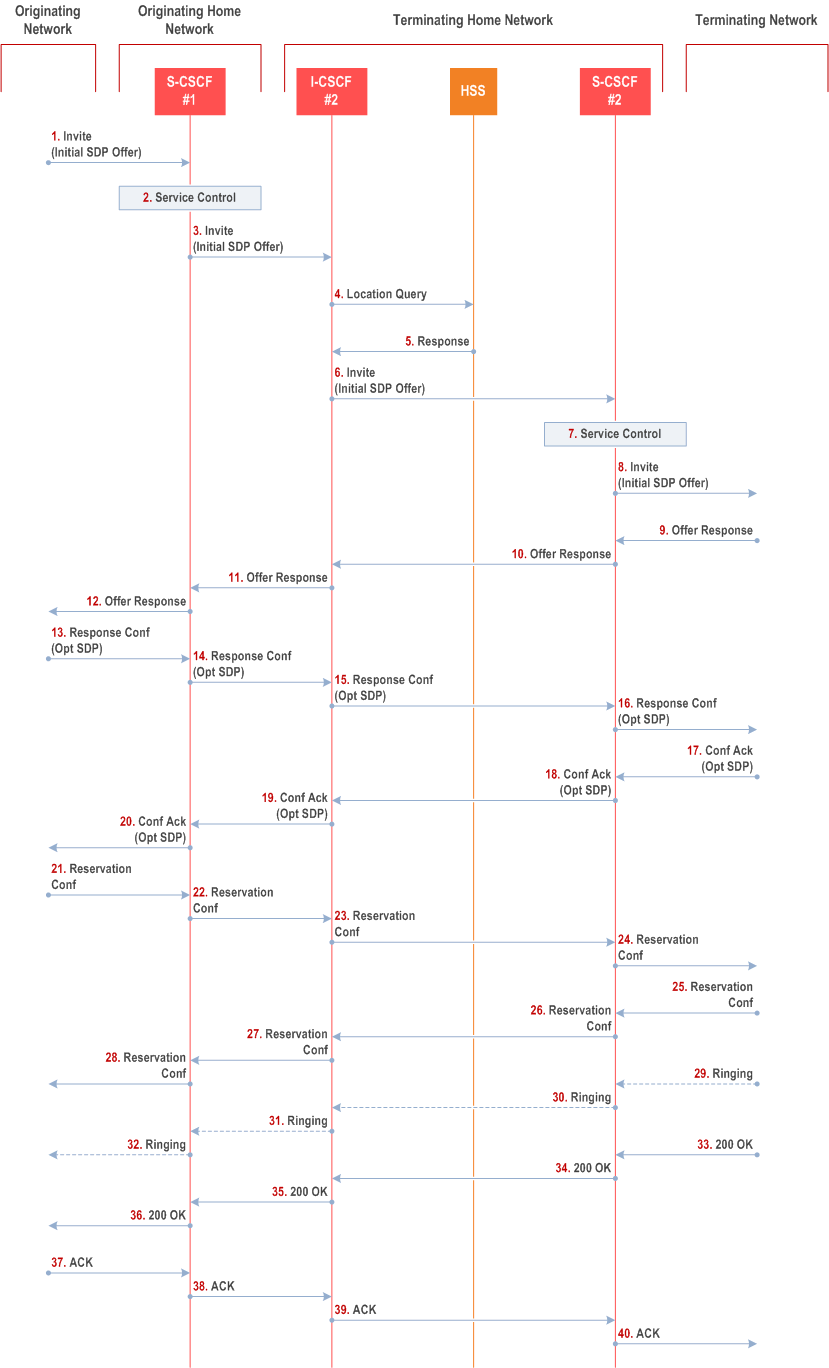Content for TS 23.228 Word version: 19.1.0
1…
3…
4…
4.2.4…
4.3…
4.4…
4.13…
4.16…
5…
5.2…
5.3…
5.4…
5.4.7…
5.4.8…
5.4a…
5.5…
5.5.3…
5.6…
5.6.3…
5.7…
5.7.3…
5.7.5…
5.7.8…
5.8…
5.10…
5.11…
5.11.3…
5.11.3.3
5.11.3.4
5.11.4…
5.11.5…
5.11.5.3…
5.11.6…
5.12…
5.16…
5.16.2…
5.19…
5.20…
A…
E…
E.2.2…
G…
G.5…
H
I…
J…
K…
L…
M…
M.3…
N…
P…
Q…
Q.2.5…
R…
S…
T…
U…
U.2…
V…
W…
X…
Y…
Z…
AA…
AA.3…
AB…
AC…
AC.7…
AC.7.2…
AC.7.2.2
AC.7.2.3…
AC.7.4…
AC.7.9…
AC.7.9.3…
AC.7.10…
AC.7.10.4.2…
AC.9…
AC.10…
AC.11…
AD…
AE…
AF…
AG…
5.5 Serving-CSCF/MGCF to serving-CSCF/MGCF procedures
5.5.0 General
5.5.1 (S-S#1) Different network operators performing origination and termination
5.5.2 (S-S#2) Single network operator performing origination and termination
...
...
5.5 Serving-CSCF/MGCF to serving-CSCF/MGCF procedures p. 112
5.5.0 General |R6| p. 112
This clause presents the detailed application level flows to define the procedures for Serving-CSCF/MGCF to Serving-CSCF/MGCF.
In the IM CN subsystem the MGCF is considered as a SIP endpoint. It translates ISUP/BICC messages of the PSTN side to SIP signalling of the IM CN subsystem side and vice-versa. It should also be noted that the MGCF does not invoke Service Control.
This clause contains four session flow procedures, showing variations on the signalling path between the Serving-CSCF that handles session origination, and the Serving-CSCF that handles session termination. This signalling path depends on:
- whether the originator and destination are served by the same network operator,
- whether the network operators have chosen to hide their internal configuration.
5.5.1 (S-S#1) Different network operators performing origination and termination p. 112
The Serving-CSCF handling session origination performs an analysis of the destination address, and determines that it belongs to a subscriber of a different operator. The request is therefore forwarded to a well-known entry point in the destination operator's network, the I-CSCF. The I-CSCF queries the HSS for current location information, and finds the user either located in the home service area, or roaming. The I-CSCF therefore forwards the request to the S-CSCF serving the destination user.
Refer to Table 5.2 in clause 5.4a to see which origination sequences share this common S-S procedure. In addition the text below clarifies the role of the" Originating Network".
MO#1
Refer to Table 5.2 in clause 5.4a to see which termination sequences share this common S-S procedure. In addition the text below clarifies the role of the" Terminating Network".
Mobile origination, roaming. The "Originating Network" of S-S#1 is therefore a visited network.
MO#2
Mobile origination, home. The "Originating Network" of S-S#1 is therefore the home network.
PSTN-O
PSTN origination. The "Originating Network" of S-S#1 is the PSTN network. The elements of Figure 5.16 replace all elements of the Originating network and Originating Home Network in Figure 5.10.
AS-O
Application Server origination. The" Originating Network" of S-S#1 is the home network. The element labelled S-CSCF#1 corresponds to the S-SCSF in Figure 5.16b.
NI-O
Non-IMS network origination. The external SIP client of Figure 5.16b replaces all elements of the Originating network and Originating Home Network in Figure 5.10. There may be other non-IMS SIP servers on the path that are not shown.
MT#1
Mobile termination, roaming. The "Terminating Network" of S-S#1 is a visited network.
MT#2
Mobile termination, located in home service area. The "Terminating Network" of S-S#1 is the home network.
MT#3
Mobile termination, CS Domain roaming. The "Terminating Network" of S-S#1 is a CS domain network.
AS-T#1,2,3,4
Application Server termination. The elements of the corresponding AS-T termination Figure (5.7.5, 5.7.6, 5.7.7, and 5.7.8) replace all elements of the Terminating Home Network and Terminating Network off Figure 5.10.
NI-T
Non-IMS network terminations. The external SIP client of figure5.19a replaces all elements of the Terminating Home Network and Terminating Network in Figure 5.10. There may be other non-IMS SIP servers on the path that are not shown.

Procedure S-S#1 is as follows:
Step 1.
The SIP INVITE request is sent from the UE to S-CSCF#1 by the procedures of the originating flow. This message should contain the initial media description offer in the SDP.
Step 2.
S-CSCF#1 invokes whatever service logic is appropriate for this session attempt.
Step 3.
S-CSCF#1 performs an analysis of the destination address, and determines the network operator to whom the subscriber belongs. For S-S#1, this flow is an inter-operator message to the I-CSCF entry point for the terminating user. S-CSCF#1 forwards the INVITE request directly to I-CSCF#2, the well-known entry point into the terminating user's network
Step 4.
I-CSCF#2 (at the border of the terminating user's network) shall query the HSS for current location information.
Step 5.
HSS responds with the address of the current Serving-CSCF for the terminating user.
Step 6.
I-CSCF#2 forwards the INVITE request to the S-CSCF (S-CSCF#2) that will handle the session termination.
Step 7.
S-CSCF#2 invokes whatever service logic is appropriate for this session setup attempt
Step 8.
The sequence continues with the message flows determined by the termination procedure.
Step 9.
The media stream capabilities of the destination are returned along the signalling path, as per the termination procedure.
Step 10.
S-CSCF#2 forwards the SDP to I-CSCF#2
Step 11.
I-CSCF#2 forwards the SDP to S-CSCF#1.
Step 12.
S-CSCF#1 forwards the SDP to the originator, as per the originating procedure.
Step 13.
The originator decides on the offered set of media streams, confirms receipt of the Offer Response with a Response Confirmation, and forwards this information to S-CSCF#1 by the origination procedures. The Response Confirmation may also contain SDP. This may be the same SDP as in the Offer Response received in Step 12 or a subset.
Step 14-15.
S-CSCF#1 forwards the offered SDP to S-CSCF#2.
Step 16.
S-CSCF#2 forwards the offered SDP to the terminating endpoint, as per the termination procedure
Step 17-20.
The terminating end point acknowledges the offer with answered SDP and passes through the session path to the originating end point.
Step 21-24.
Originating end point acknowledges successful resource reservation and the message is forwarded to the terminating end point.
Step 25-28.
Terminating end point acknowledges the response and this message is sent to the originating end point through the established session path.
Step 29-32.
Terminating end point then generates ringing and this message is sent to the originating end point through the established session path.
Step 33-36.
Terminating end point then sends 200 OK via the established session path to the originating end point.
Step 37-40.
Originating end point acknowledges the establishment of the session and sends to the terminating end point via the established session path.
5.5.2 (S-S#2) Single network operator performing origination and termination p. 114
The Serving-CSCF handling session origination performs an analysis of the destination address, and determines that it belongs to a subscriber of the same operator. The request is therefore forwarded to a local I-CSCF. The I-CSCF queries the HSS for current location information, and finds the user either located in the home service area, or roaming. The I-CSCF therefore forwards the request to the S-CSCF serving the destination user.
Refer to Table 5.2 in sub clause 5.4a to see which origination sequences share this common S-S procedure. In addition the text below clarifies the role of the" Originating Network".
MO#1
Refer to Table 5.2 in clause 5.4a to see which termination sequences share this common S-S procedure. In addition the text below clarifies the role of the" Terminating Network".
Mobile origination, roaming. The "Originating Network" of S-S#2 is therefore a visited network.
MO#2
Mobile origination, home. The "Originating Network" of S-S#2 is therefore the home network.
AS-O
Application Server origination. The" Originating Network" of S-S#1 is the home network. The element labelled S-CSCF#1 corresponds to the S-CSCF in Figure 5.16b.
MT#1
Mobile termination, roaming,. The "Terminating Network" of S-S#2 is a visited network.
MT#2
Mobile termination, home. The "Terminating Network" of S-S#2 is the home network.
MT#3
Mobile termination, CS Domain roaming. The "Terminating Network" of S-S#2 is a CS domain network.
AS-T#1,2,3,4
Application Server termination. The elements of the corresponding AS-T termination Figure (clause 5.7.5, clause 5.7.6, clause 5.7.7, and clause 5.7.8) replace all elements of the Terminating Home Network and Terminating Network off Figure 5.11.

Procedure S-S#2 is as follows:
Step 1.
The SIP INVITE request is sent from the UE to S-CSCF#1 by the procedures of the originating flow. This message should contain the initial media description offer in the SDP.
Step 2.
S-CSCF#1 invokes whatever service logic is appropriate for this session setup attempt
Step 3.
S-CSCF#1 performs an analysis of the destination address, and determines the network operator to whom the subscriber belongs. Since it is local, the request is passed to a local I-CSCF.
Step 4.
I-CSCF shall query the HSS for current location information.
Step 5.
HSS responds with the address of the current Serving-CSCF for the terminating user.
Step 6.
I-CSCF forwards the INVITE request to the S-CSCF (S-CSCF#2) that will handle the session termination.
Step 7.
S-CSCF#2 invokes whatever service logic is appropriate for this session setup attempt
Step 8.
The sequence continues with the message flows determined by the termination procedure.
Step 9-12.
The terminating end point responds with an answer to the offered SDP and this message is passed along the established session path.
Step 13-16.
The originator decides on the offered set of media streams, confirms receipt of the Offer Response with a Response Confirmation, and forwards this information to S-CSCF#1 by the origination procedures. This message is forwarded via the established session path to the terminating end point. The Response Confirmation may also contain SDP. This may be the same SDP as in the Offer Response received in Step 12 or a subset.
Step 17-20.
Terminating end point responds to the offered SDP and the response if forwarded to the originating end point via the established session path.
Step 21-24.
Originating end point sends successful resource reservation information towards the terminating end point via the established session path.
Step 25-28.
Terminating end point sends successful resource reservation acknowledgement towards the originating end point via the established session path
Step 29-32.
Terminating end point sends ringing message toward the originating end point via the established session path.
Step 33-36.
The SIP final response, 200-OK, is sent by the terminating endpoint over the signalling path. This is typically generated when the user has accepted the incoming session setup attempt. The message is sent to S-CSCF#2 per the termination procedure.
Step 37-40.
The originating endpoint sends the final acknowledgement to S-CSCF#1 by the origination procedures and it is then sent over the signalling path to the terminating end point.